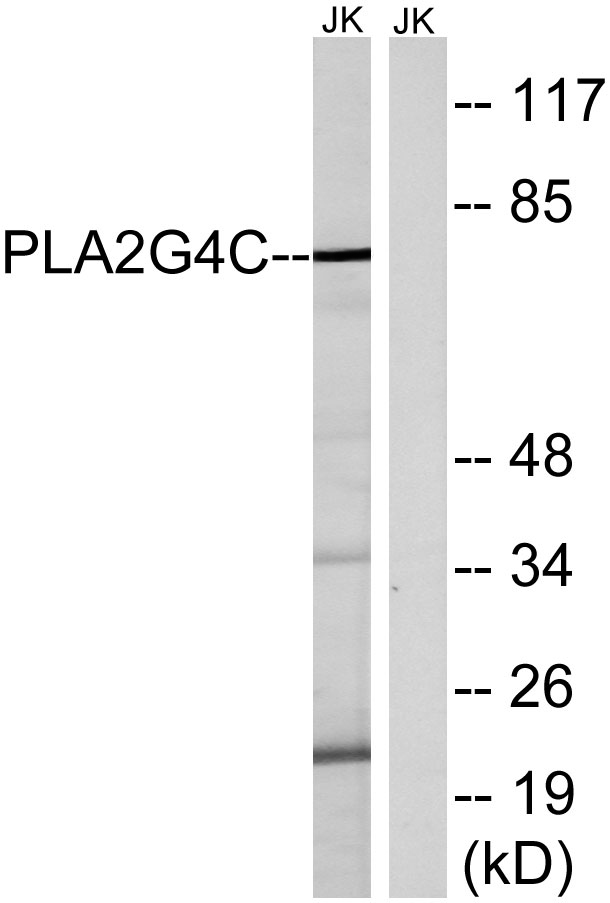cPLA2-γ Polyclonal Antibody
- Catalog No.:YT1085
- Applications:WB;ELISA
- Reactivity:Human;Mouse
- Target:
- cPLA2-γ
- Fields:
- >>Glycerophospholipid metabolism;>>Ether lipid metabolism;>>Arachidonic acid metabolism;>>Linoleic acid metabolism;>>alpha-Linolenic acid metabolism;>>Metabolic pathways;>>MAPK signaling pathway;>>Ras signaling pathway;>>Phospholipase D signaling pathway;>>Necroptosis;>>Vascular smooth muscle contraction;>>VEGF signaling pathway;>>Platelet activation;>>Fc epsilon RI signaling pathway;>>Fc gamma R-mediated phagocytosis;>>Glutamatergic synapse;>>Serotonergic synapse;>>Long-term depression;>>Inflammatory mediator regulation of TRP channels;>>GnRH signaling pathway;>>Ovarian steroidogenesis;>>Oxytocin signaling pathway;>>Choline metabolism in cancer
- Gene Name:
- PLA2G4C
- Protein Name:
- Cytosolic phospholipase A2 gamma
- Human Gene Id:
- 8605
- Human Swiss Prot No:
- Q9UP65
- Immunogen:
- The antiserum was produced against synthesized peptide derived from human PLA2G4C. AA range:301-350
- Specificity:
- cPLA2-γ Polyclonal Antibody detects endogenous levels of cPLA2-γ protein.
- Formulation:
- Liquid in PBS containing 50% glycerol, 0.5% BSA and 0.02% sodium azide.
- Source:
- Polyclonal, Rabbit,IgG
- Dilution:
- WB 1:500 - 1:2000. ELISA: 1:20000. Not yet tested in other applications.
- Purification:
- The antibody was affinity-purified from rabbit antiserum by affinity-chromatography using epitope-specific immunogen.
- Concentration:
- 1 mg/ml
- Storage Stability:
- -15°C to -25°C/1 year(Do not lower than -25°C)
- Other Name:
- PLA2G4C;Cytosolic phospholipase A2 gamma;cPLA2-gamma;Phospholipase A2 group IVC
- Observed Band(KD):
- 70kD
- Background:
- This gene encodes a protein which is a member of the phospholipase A2 enzyme family which hydrolyzes glycerophospholipids to produce free fatty acids and lysophospholipids, both of which serve as precursors in the production of signaling molecules. The encoded protein has been shown to be a calcium-independent and membrane bound enzyme. Multiple transcript variants encoding different isoforms have been found for this gene. [provided by RefSeq, Apr 2009],
- Function:
- catalytic activity:Phosphatidylcholine + H(2)O = 1-acylglycerophosphocholine + a carboxylate.,enzyme regulation:Not regulated by calcium.,function:Has a preference for arachidonic acid at the sn-2 position of phosphatidylcholine as compared with palmitic acid.,similarity:Contains 1 PLA2c domain.,tissue specificity:Highly expressed in heart and skeletal muscle.,
- Subcellular Location:
- Cell membrane ; Lipid-anchor . Endoplasmic reticulum membrane ; Lipid-anchor. Mitochondrion membrane ; Lipid-anchor. Lipid droplet . Translocates from endoplasmic reticulum to lipid droplets in response to oleate. .
- Expression:
- Highly expressed in heart and skeletal muscle.
- June 19-2018
- WESTERN IMMUNOBLOTTING PROTOCOL
- June 19-2018
- IMMUNOHISTOCHEMISTRY-PARAFFIN PROTOCOL
- June 19-2018
- IMMUNOFLUORESCENCE PROTOCOL
- September 08-2020
- FLOW-CYTOMEYRT-PROTOCOL
- May 20-2022
- Cell-Based ELISA│解您多样本WB检测之困扰
- July 13-2018
- CELL-BASED-ELISA-PROTOCOL-FOR-ACETYL-PROTEIN
- July 13-2018
- CELL-BASED-ELISA-PROTOCOL-FOR-PHOSPHO-PROTEIN
- July 13-2018
- Antibody-FAQs
- Products Images

- Western blot analysis of lysates from Jurkat cells, using PLA2G4C Antibody. The lane on the right is blocked with the synthesized peptide.

- Western blot analysis of the lysates from HeLa cells using PLA2G4C antibody.



